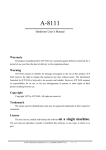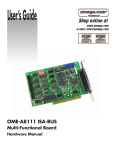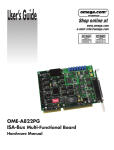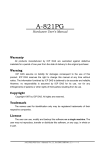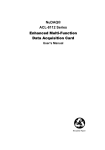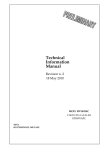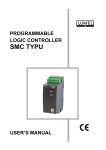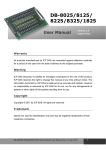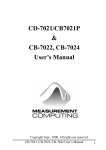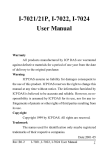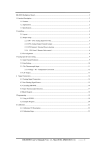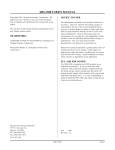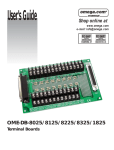Download A-812PG. Hardware User`s Manual
Transcript
A-812PG Hardware User’s Manual Warranty All products manufactured by ICP DAS are warranted against defective materials for a period of one year from the date of delivery to the original purchaser. Warning ICP DAS assume no liability for damages consequent to the use of this product. ICP DAS reserves the right to change this manual at any time without notice. The information furnished by ICP DAS is believed to be accurate and reliable. However, no responsibility is assumed by ICP DAS for its use, nor for any infringements of patents or other rights of third parties resulting from its use. Copyright Copyright 1997 by ICP DAS. All rights are reserved. Trademark The names used for identification only maybe registered trademarks of their respective companies. License The user can use, modify and backup this software on a single machine. The user may not reproduce, transfer or distribute this software, or any copy, in whole or in part. A-812PG Hardware Manual----1 Tables of Contents 1. Introduction ___________________________________________________________4 1.1 General Description ______________________________________________________ 4 1.2 Features _________________________________________________________________ 4 1.3 Specifications _____________________________________________________________ 5 1.3.1 Power Consumption :____________________________________________________________5 1.3.2 Analog Inputs__________________________________________________________________5 1.3.3 A/D Converter _________________________________________________________________5 1.3.4 DA Converter _________________________________________________________________6 1.3.5 Digital I/O ____________________________________________________________________6 1.3.6 Interrupt Channel _______________________________________________________________6 1.3.7 Programmable Timer/Counter _____________________________________________________7 1.3.8 Direct Memory Access Channel (DMA) _____________________________________________7 2 1.4 Applications ______________________________________________________________ 8 1.5 Product Check List ________________________________________________________ 8 Hardware Configuration__________________________________________________9 2.1 Board Layout _____________________________________________________________ 9 2.2 I/O Base Address Setting __________________________________________________ 10 2.3 Jumper Setting___________________________________________________________ 11 2.3.1 JP3 : D/A Internal Reference Voltage Selection ______________________________________11 2.3.2 JP1, JP2 : D/A Int/Ext Ref Voltage Selection_______________________________________12 2.3.3 JP8 : A/D Trigger Source Selection________________________________________________12 2.3.4 JP5 : Interrupt Level Selection____________________________________________________13 2.3.5 JP9 : User Timer/Counter Clock Input Selection______________________________________14 2.3.6 JP6 : DMA DACK Selection, 2.4 JP7 : DMA DRQ Selection _________________15 I/O Register Address______________________________________________________ 16 2.4.1 8254 Counter _________________________________________________________________17 2.4.2 A/D Input Buffer Register _______________________________________________________17 2.4.3 D/A Output Latch Register ______________________________________________________18 2.4.4 D/I Input Buffer Register ________________________________________________________19 2.4.5 Clear Interrupt Request _________________________________________________________19 2.4.6 A/D Gain Control Register ______________________________________________________20 2.4.7 A/D Multiplex Control Register __________________________________________________21 2.4.8 A/D Mode Control Register______________________________________________________21 2.4.8 A/D Software Trigger Control Register_____________________________________________23 A-812PG Hardware Manual----2 2.4.9 D/O Output Latch Register ______________________________________________________24 2.5 Digital I/O_______________________________________________________________ 25 2.6 8254 Timer/Counter ______________________________________________________ 26 2.7 A/D Conversion __________________________________________________________ 27 2.7.1 A/D conversion flow ___________________________________________________________28 2.7.2 A/D Conversion Trigger Modes __________________________________________________29 2.7.3 A/D Transfer Modes ___________________________________________________________29 2.7.4 Using software trigger and polling transfer __________________________________________30 2.8 D/A Conversion __________________________________________________________ 31 2.9 Analog Input Signal Connection ____________________________________________ 32 2.10 Pin Assignment ___________________________________________________________ 33 2.11 Daughter Board __________________________________________________________ 34 2.11.1 DN-20 for Analog input / output _________________________________________________34 2.11.2 DB-16P for Digital input _______________________________________________________34 2.11.3 DB-16R for Digital output______________________________________________________34 3. Calibration ___________________________________________________________35 3.1 Calibration VR Description ________________________________________________ 36 3.2 D/A Calibration Steps _____________________________________________________ 37 3.3 A/D Calibration Steps _____________________________________________________ 37 A-812PG Hardware Manual----3 1. Introduction 1.1 General Description The A-812PG is a high performance, multifunction analog, digital I/O board for the PC AT compatible computer. The A-812PG provides low gain (1, 2, 4, 8, 16). The A-812PG contains a 12-bit ADC with up to 16 single-ended analog inputs. The maximum sample rate of A/D converter is about 62.5K sample/sec. There are two 12-bits DAC with voltage outputs, 16 channels of TTL-compatible digital input, 16 channels of TTL-compatible digital output and one 16-bit counter/timer channel for timing input and output. 1.2 Features The maximum sample rate of A/D converter is about 62.5 K sample/sec Software selectable input ranges PC AT compatible ISA bus A/D trigger mode : software trigger , pacer trigger, external trigger 16 single-ended or 8 differential analog input signals Programmable low gain : 1,2,4,8,16 2 channel 12-bit D/A voltage output 16 digital input /16 digital output (TTL compatible) Interrupt handling 1 channel general purpose programmable 16 bits timer/counter A-812PG Hardware Manual----4 1.3 Specifications 1.3.1 Power Consumption : +5V @960 mA maximum, A-812PG Operating temperature : -20°C ~ 60°C 1.3.2 Analog Inputs Channels : 16 single-ended Input range : (software programmable) A-812PG:bipolar : ±10V,±5V, ±2.5V, ±1.25V, ±0.625V, ±0.3125V (input range : ±10V by Jumper Select ) Input current : 250 nA max (125 nA typical ) at 25 deg. On chip sample and hold Over voltage : continuous single channel to 70Vp-p Input impedance : 10 10 Ω // 6pF 1.3.3 A/D Converter Type : successive approximation , Burr Brown ADS 774 or SIPEX-SP774B ( equivalent) Conversion time : 8 microsec. Accuracy : +/- 1 bit Resolution : 12 bits A-812PG Hardware Manual----5 1.3.4 Channels : 2 independent Type : 12 bit multiplying , Analog device AD-7541 Linearity : +/- 1/2 bit Output range : 0~5V or 0~10V jumper selected , may be used with other AC or DC reference input Maximum output limit +/- 10V Output drive : +/- 5mA settling time : 0.6 microseconds to 0.01% for full scale step 1.3.5 Digital I/O Output port : 16 bits, TTL compatible Input port : 16 bits, TTL compatible 1.3.6 DA Converter Interrupt Channel Level : 3,4,5,6,7,9,10,11,12,14,15, jumper selectable Enable : Via control register A-812PG Hardware Manual----6 1.3.7 Type : 82C54 -8 programmable timer/counter Counters: The counter1 and counter2 are cascaded as a 32 bits pacer timer The counter0 is used as user timer/counter. The software driver use counter0 to implement a machine independent timer. Clock input frequency : DC to 10 MHz Pacer output : 0.00047Hz to 0.5MHz Input ,gate : TTL compatible Internal Clock : 2M Hz 1.3.8 Programmable Timer/Counter Direct Memory Access Channel (DMA) Level : CH1 or CH3, jumper selectable Enable : via DMA bit of control register Termination : by interrupt on T/C Transfer rate : 100K conversions/sec.(DOS Software manual, sec. 4.11) A-812PG Hardware Manual----7 1.4 Applications Signal analysis FFT & frequency analysis Transient analysis Production test Process control Vibration analysis Energy management Industrial and lab. measurement and control 1.5 Product Check List In addition to this manual, the package includes the following items: A-812PG multifunction card A-812PG utility diskette A-812PG DOS software menu Attention ! If any of these items is missing or damaged, contact the dealer who provides you this product. Save the shipping materials and carton in case you want to ship or store the product in the future. A-812PG Hardware Manual----8 2. 2.1 Hardware Configuration Board Layout A-812PG CN1 CN2 JP5 ISA BUS JP1 JP2 SW1 12345 JP3 JP4 JP6 ISA BUS CN3 JP7 JP 8 CN1 CN2 JP 9 A-812PG Hardware Manual----9 VR BB ADS-774 2.2 I/O Base Address Setting The A-812PG occupies 16 consecutive locations in I/O address space. The base address is set by DIP switch SW1. The default address is 0x220. A9 A8 A7 A6 A5 A4` 1 2 3 4 5 6 ON SW1 : BASE ADDRESS BASE ADDR A9 A8 A7 A6 A5 A4 200-20F OFF ON ON ON ON ON 210-21F OFF ON ON ON ON OFF 220-22F( ) OFF ON ON ON OFF ON 230-23F OFF ON ON ON OFF OFF : : : : : : : 300-30F OFF OFF ON ON ON ON : : : : : : : 3F0-3FF OFF OFF OFF OFF OFF ( ) : default base address is 0x220 A-812PG Hardware Manual----10 The PC I/O port mapping is given below. ADDRESS Device ADDRESS DEVICE 000-1FF PC reserved 320-32F XT Hard Disk 200-20F Game/control 378-37F Parallel Printer 210-21F XT Expansion Unit 380-38F SDLC 238-23F Bus Mouse/Alt. Bus Mouse 3A0-3AF SDLC 278-27F Parallel Printer 3B0-3BF MDA/Parallel Printer 2B0-2DF EGA 3C0-3CF EGA 2E0-2E7 AT GPIB 3D0-3DF CGA 2E8-2EF Serial Port 3E8-3EF Serial Port 2F8-2FF Serial Port 3F0-3F7 Floppy Disk 300-31F Prototype Card 3F8-3FF Serial Port 2.3 Jumper Setting 2.3.1 JP3 : D/A Internal Reference Voltage Selection Reference Voltage -5V (default) (-10V) (-5V) Reference Voltage -10V (-10V) JP3 Select (-5V) : D/A voltage output = 0 to 5V (both channel) Select (-10V) : D/A voltage output = 0 to 10V (both channel) JP1 is validate only if JP2 select D/A internal reference voltage A-812PG Hardware Manual----11 (-5V) JP3 2.3.2 JP1, JP2 : D/A Int/Ext Ref Voltage Selection Ch 1 = INT Ch 2 = INT (default) JP2(vref) Ch 1 =EXT (ExtRef1) Ch 2 =EXT (ExtRef2) JP2(vref) Ch 1 = INT Ch 2 =EXT (ExtRef2) JP2(vref) Ch 1 =EXT (ExtRef1) Ch 2 = INT JP2(vref) If JP2 select internal reference, then JP1 select -5V/-10V internal reference voltage. If JP2 select external reference, then ExtRef1, CN3 pin 31, is the external reference voltage for DA channel 1. and ExtRef2, CN3 pin 12, is the external reference voltage for DA Channel 2. If user provides AC +/- 10V external reference voltage, the D/A output voltage may be AC -/+ 10V 2.3.3 JP8 : A/D Trigger Source Selection Internal Trigger (default) INTTRG External Trigger EXTTRG INTTRG EXTTRG The A-812PG supports two trigger type, internal trigger and external trigger. The external trigger comes from ExtTrg, CN3 pin 17. There are two types of internal trigger, software trigger and pacer trigger. A-812PG Hardware Manual----12 2.3.4 JP5 : Interrupt Level Selection NO Interrupt IRQ 3 4 5 6 7 9 10 11 12 14 15 NC IRQ 3 4 5 6 7 9 10 11 12 14 15 NC Interrupt 15 (default) The interrupt channel can not be shared. The A-812PG software driver can support 8 different boards in one system but only 2 of these cards can use interrupt transfer function. A-812PG Hardware Manual----13 2.3.5 JP9 : User Timer/Counter Clock Input Selection Internal 2M Clock (default) INTCLK External Clock EXTCLK INTCLK EXTCLK The A-812PG has 3 independent 16 bits timer/counter. The cascaded counter1 and counter2 are used as pacer timer. The counter0 can be used as a user programmable timer/counter. The user programmable timer/counter can select 2M internal clock or external clock ExtCLK, CN3 pin 37. The block diagram is given in section 2.6. The clock source must be very stable. It is recommended to use internal 2M clock. The 822PGL/PGH software driver use the counter0 as a machine independent timer. If user program call A-812PG_Delay() subroutine, the counter0 will be programmed as a machine independent timer. The detail information is given in section 2.6. A-812PG Hardware Manual----14 2.3.6 JP6 : DMA DACK Selection, JP7 : DMA DRQ Selection DRQ NO DMA DMA 1 (default) DACK 1 2 1 2 5 6 5 6 JP7 JP8 DRQ DACK 1 2 1 2 5 6 5 6 DMA 3 JP7 JP8 DRQ DACK 1 2 1 2 5 6 5 6 JP7 JP8 The DMA channel can not shared. The A-812PG software driver can support 8 different boards in one PC based system, but only two of these boards can use DMA transfer function. A-812PG Hardware Manual----15 2.4 I/O Register Address The A-812PG occupies 16 consecutive PC I/O addresses. The following table lists the registers and their locations. Address Read Write Base+0 8254 Counter 0 8254 Counter 0 Base+1 8254 Counter 1 8254 Counter 1 Base+2 8254 Counter 2 8254 Counter 2 Base+3 Reserved 8254 Counter Control Base+4 A/D Low Byte D/A Channel 0 Low Byte Base+5 A/D High Byte D/A Channel 0 High Byte Base+6 DI Low Byte D/A Channel 1 Low Byte Base+7 DI High Byte D/A Channel 1 High Byte Base+8 Reserved A/D Clear Interrupt Request Base+9 Reserved A/D Gain Control Base+A Reserved A/D Multiplexer Control Base+B Reserved A/D Mode Control Base+C Reserved A/D Software Trigger Control Base+D Reserved DO Low Byte Base+E Reserved DO High Byte Base+F Reserved Reserved A-812PG Hardware Manual----16 2.4.1 8254 Counter The 8254 Programmable timer/counter has 4 registers from Base+0 through Base+3. For detailed programming information about 8254 , please refer to Intel‘s “Microsystem Components Handbook”. Address Read Write Base+0 8254 Counter 0 8254 Counter 0 Base+1 8254 Counter 1 8254 Counter 1 Base+2 8254 Counter 2 8254 Counter 2 Base+3 Reserved 8254 Counter Control 2.4.2 A/D Input Buffer Register (READ) Base+4 : A/D Low Byte Data Format Bit 7 Bit 6 Bit 5 Bit 4 Bit 3 Bit 2 Bit 1 Bit 0 D7 D6 D5 D4 D3 D2 D1 D0 (READ) Base+5 : A/D High Byte Data Format Bit 7 Bit 6 Bit 5 Bit 4 Bit 3 Bit 2 Bit 1 Bit 0 0 0 0 READY D11 D10 D9 D8 A/D 12 bits data : D11…..D0, D11=MSB, D0=LSB READY =1 : A/D 12 bits data not ready =0 : A/D 12 bits data is ready The low 8 bits A/D data are stored in address BASE+4 and the high 4 bits data are stored in address BASE+5. The READY bit is used as a indicator for A/D conversion. When a A/D conversion is completed, the READY bit will be clear to zero. A-812PG Hardware Manual----17 2.4.3 D/A Output Latch Register (WRITE) Base+4 : Channel 1 D/A Low Byte Data Format Bit 7 Bit 6 Bit 5 Bit 4 Bit 3 Bit 2 Bit 1 Bit 0 D7 D6 D5 D4 D3 D2 D1 D0 (WRITE) Base+5 :Channel 1 D/A High Byte Data Format Bit 7 Bit 6 Bit 5 Bit 4 Bit 3 Bit 2 Bit 1 Bit 0 X X X X D11 D10 D9 D8 (WRITE) Base+6 : Channel 2 D/A Low Byte Data Format Bit 7 Bit 6 Bit 5 Bit 4 Bit 3 Bit 2 Bit 1 Bit 0 D7 D6 D5 D4 D3 D2 D1 D0 (WRITE) Base+7 :Channel 2 D/A High Byte Data Format Bit 7 Bit 6 Bit 5 Bit 4 Bit 3 Bit 2 Bit 1 Bit 0 X X X X D11 D10 D9 D8 D/A 12 bits output data : D11..D0, D11=MSB, D0=LSB, X=don‘t care The D/A converter will convert the 12 bits digital data to analog output. The low 8 bits of D/A channel 1 are stored in address BASE+4 and high 4 bits are stored in address BASE+5. The address BASE+6 and BASE+7 store the 12 bits data for D/A channel 2. The D/A output latch registers are designed as a “double buffered” structure, so the analog output latch registers will be updated until the high 4 bits digital data are written. If the user send the high 4 bits data first, the DA 12 bits output latch registers will update at once. So the low 8 bits will be the previous data latched in register. This action will cause an error on DA output voltage. So the user must send low 8 bits first and then send high 4 bits to update the 12 bits AD output latch register. NOTE : Send low 8 bits first, then send high 4 bits. A-812PG Hardware Manual----18 2.4.4 D/I Input Buffer Register (READ) Base+6 : D/I Input Buffer Low Byte Data Format Bit 7 Bit 6 Bit 5 Bit 4 Bit 3 Bit 2 Bit 1 Bit 0 D7 D6 D5 D4 D3 D2 D1 D0 (READ) Base+7 : D/I Input Buffer High Byte Data Format Bit 7 Bit 6 Bit 5 Bit 4 Bit 3 Bit 2 Bit 1 Bit 0 D15 D14 D13 D12 D11 D10 D9 D8 D/I 16 bits input data : D15..D0, D15=MSB, D0=LSB The A-812PG provides 16 TTL compatible digital input. The low 8 bits are stored in address BASE+6. The high 8 bits are stored in address BASE+7. 2.4.5 Clear Interrupt Request (WRITE) Base+8 : Clear Interrupt Request Format Bit 7 Bit 6 Bit 5 Bit 4 Bit 3 Bit 2 Bit 1 Bit 0 X X X X X X X X X=don‘t care, XXXXXXXX=any 8 bits data is validate If A-812PG is working in the interrupt transfer mode, a on-board hardware status bit will be set after each A/D conversion. This bit must be clear by software before next hardware interrupt. Writing any value to address BASE+8 will clear this hardware bit and the hardware will generate another interrupt when next A/D conversion is completed. A-812PG Hardware Manual----19 2.4.6 A/D Gain Control Register (WRITE) Base+9 : A/D Gain Control Register Format y Bit 6 Bit 5 Bit 4 Bit 3 Bit 2 Bit 1 Bit 0 X X X X X GAIN2 GAIN1 GAIN0 The Only difference between A-812PG and A-812PG is the GAIN control function. The A812PG provides gain factor of 1/2/4/8/16. The gain control register control the gain of A/D input signal. Bipolar/Unipolar will effect the gain factor. NOTE : If gain control code changed, the hardware need to delay extra gain settling time. The gain settling time is different for different gain control code. The software driver does not take care the gain settling time, so the user need to delay the gain settling time if gain changed. If the application program need to run in different machines, the user need to implement a machine independent timer. A-812PG GAIN CONTROL CODE TABLE Settling Time GAIN Input Range GAIN2 GAIN1 GAIN0 23 us 1 +/- 5V 0 0 0 23 us 2 +/- 2.5V 0 0 1 25 us 4 +/- 1.25V 0 1 0 28 us 8 +/- 0.0625V 0 1 1 23 us 16 +/- 10V 1 0 0 BI=Bipolar, UNI=Unipolar, X=don‘t care, N/A=not available A-812PG Hardware Manual----20 2.4.7 A/D Multiplex Control Register (WRITE) Base+A : A/D Multilexer Control Register Format Bit 7 Bit 6 Bit 5 Bit 4 Bit 3 Bit 2 Bit 1 Bit 0 X X X X X D2 D1 D0 A/D input channel selection data = 4 bits : D3..D0, D3=MSB, D0=LSB, X=don‘t care Single-ended mode : D3..D0 Differential mode : D2..D0, D3=don’t care The A-812PG provides 16 single-ended or 8 differential analog input signals. In single-ended mode D3..D0 select the active channel. In differential mode D2..D0 select the active channel and D3 will be don’t care. 2.4.8 A/D Mode Control Register (WRITE) Base+B : A/D Mode Control Register Format Bit 7 Bit 6 Bit 5 Bit 4 Bit 3 Bit 2 Bit 1 Bit 0 X X X X X D2 D1 D0 X=don‘t care JP4 Select Internal Trigger Mode Select Trigger Type Transfer Type D2 D1 D0 Software Trig Pacer Trig Software Interrupt DMA 0 0 0 X X X X X 0 0 1 Select X Select X X 0 1 0 X Select X X Select 1 1 0 X Select Select Select X X=disable A-812PG Hardware Manual----21 JP4 Select External Trigger Mode Select Trigger Type Transfer Type D2 D1 D0 External Trigger Software Interrupt DMA 0 0 0 X X X X 0 0 1 X X X X 0 1 0 Select X X Select 1 1 0 Select Select Select X The A/D conversion operation can be divided into 2 stage, trigger stage and transfer stage. The trigger stage will generate a trigger signal to A/D converter and the transfer stage will transfer the result to the CPU. The trigger method may be internal trigger or external trigger. The internal trigger can be software trigger or pacer trigger. The software trigger is very simple but can not control the sampling rate very precisely. In software trigger mode, the program issues a software trigger command any time needed. Then the program will poll the A/D status bit until the ready bit is 0. The pacer trigger can control the sampling rate very precisely. So the converted data can be used to reconstructed the waveform of analog input signal. In pacer trigger mode, the pacer timer will generate trigger signals to A/D converter periodic. These converted data can be transfer to the CPU by polling or interrupt or DMA transfer method. The software driver provides three data transfer methods, polling, interrupt and DMA. The polling subroutine, A-812PG_AD_PollingVar() or A-812PG_AD_PollingArray(), set A/D mode control register to 0x01. This control word means software trigger and polling transfer. The interrupt subroutine, A-812PG_AD_INT_START(…), set A/D mode control mode register to ox06. This control word means pacer trigger and interrupt transfer. The DMA subroutine, A-812PG_AD_DMA_START(…), set A/D mode control register to 0x02. This control word means pacer trigger and DMA transfer. A-812PG Hardware Manual----22 2.4.9 A/D Software Trigger Control Register (WRITE) Base+C : A/D Software Trigger Control Register Format Bit 7 Bit 6 Bit 5 Bit 4 Bit 3 Bit 2 Bit 1 Bit 0 X X X X X X X X X=don‘t care, XXXXXXXX=any 8 bits data is validate The A/D converter can be triggered by software trigger or pacer trigger. Writing any value to address BASE+C will generate a trigger pulse to A/D converter and initiated a A/D conversion operation. The address BASE+5 offers a ready bit to indicate a A/D conversion complete. The software driver use this control word to detect the A-812PG hardware board. The software initiates a software trigger and check the ready bit . If the ready bit can not clear to zero in a fixed time, the software driver will return a error message. If the I/O BASE address setting error, the ready bit will not be clear to zero. The software driver, A812PG_CheckAddress(), use this method to detect the correctness of I/O BASE address setting A-812PG Hardware Manual----23 2.4.10 D/O Output Latch Register (WRITE) Base+D : D/O Output Latch Low Byte Data Format Bit 7 Bit 6 Bit 5 Bit 4 Bit 3 Bit 2 Bit 1 Bit 0 D7 D6 D5 D4 D3 D2 D1 D0 (WRITE) Base+E : D/O Output Latch High Byte Data Format Bit 7 Bit 6 Bit 5 Bit 4 Bit 3 Bit 2 Bit 1 Bit 0 D15 D14 D13 D12 D11 D10 D9 D8 D/O 16 bits output data : D15..D0, D15=MSB, D0=LSB The A-812PG provide 16 TTL compatible digital output. The low 8 bits are stored in address BASE+D. The high 8 bits are stored in address BASE+E A-812PG Hardware Manual----24 2.5 Digital I/O The A-812PG provides 16 digital input channels and 16 digital output channels. All levels are TTL compatible. The connections diagram and block diagram are given below: Output Latch Register Base+D Latch CN4 D0..D7 D0..D7 Power on reset Reset Reset D8..D15 Base+E 1..8 TTL DI DGND 17..18 DGND 9..16 Latch External Device Output Latch Register A-812PG Input Buffer Register Base+6 A-812PG Read CN5 D0..D7 D0..D7 D8..D15 Base+7 Read 1..8 17..18 DGND TTL DO DGND 9..16 Input Buffer Register External Device A-812PG Hardware Manual----25 2.6 8254 Timer/Counter The 8254 Programmable timer/counter has 4 resgisters from Base+0 through Base+3. For detailed programming information about 8254 , please refer to Intel‘s “Microsystem Components Handbook”.The block diagram is as below. VCC 10K CN3.12 CN3.10 Gate JP9 Cin CN3. Pin 8 Cout Counter 0 2M PACER CLK Cin : clock input Cout : clock output INTCLK : internal clock CN3 : connector CN3 CN3.14 VCC Counter 1 Cin Gate Cout 10K Counter 2 4M 2M INTCLK Cin Gate Cout CN3.6 The counter0, counter1 and counter2 are all 16 bits counter. The counter 1 and counter 2 cascade as a 32 bits timer. A-812PG Hardware Manual----26 2.7 A/D Conversion This section explains how to use A/D conversions. The A/D conversion can be triggered in any of 3 ways, by software trigger, by pacer trigger or by external trigger to the A/D converter. At the end of A/D conversion, it is possible to transfer data by any of 3 ways, those are polling , interrupt and DMA. Before use the A/D conversion function, user should notice the following issue: A/D data register, BASE+4/BASE+5, store the A/D conversion data A/D gain control register, BASE+9, select gain A/D multiplex control register, BASE+A, select analog input A/D mode control register, BASE+B, select trigger type and transfer type A/D software trigger control register, BASE+C JP8 select internal/external trigger JP5 select IRQ level JP9 select internal/external clock for counter0 JP6,JP7 select DMA channel 3 trigger logic : software, pacer, external trigger 3 transfer logic : polling, interrupt, DMA The block diagram is given below: CN1 CN2 16 CH. Multiplexer Gain control 12 bits A/D Buffer Memory Base+A Base+9 Trigger Logic Transfer Logic CPU Base+C JP8 Base+B A-812PG A-812PG Hardware Manual----27 JP5 JP6 JP7 2.7.1 A/D conversion flow Before using the A/D converter, the user should setup the following hardware item : 1. 2. 3. 4. select internal trigger or external trigger (JP8) select IRQ level if needed (JP5) select DMA channel if needed (JP6,JP7) select internal clock or external clock for counter0 if needed (JP9) Then the user must decide which A/D conversion mode will be used. The software driver supports three different modes: polling, interrupt and DMA. The user can control the A/D conversion by polling mode very easy. It is recommended to use the software driver if using interrupt or DMA mode. The analog input signals come from CN3. These signals may be single-ended or differential type and must match with the setting of JP3. The multiplexer can select 16 single-ended or 8 differential signals into the gain control module. The settling time of multiplexer depends on the source resistance. Because the software don’t take care the settling time, the user should delay enough settling time if switching from one channel to next channel. The gain control module also need settling time if gain control code changed. Because the software don’t take care the settling time, the user should delay enough settling time if gain control code is changed. The software driver provides a machine independent timer , A-812PG_Delay(), for settling time delay. This subroutine assume that JP6 select internal 2M clock and use counter0 to implement a machine independent timer. If the user call A-812PG_delay(), the counter0 will be reserved and can’t be used as a user programmable timer/counter. The output of gain control module feed into the A/D converter. The A/D converter need a trigger signal to start a A/D conversion cycle. The A-812PG supports three trigger mode, software, pacer and external trigger. The result of A/D conversion can be transfer into CPU by three mode : polling, interrupt and DMA. The operation mode is introduced in. A-812PG Hardware Manual----28 2.7.2 A/D Conversion Trigger Modes A-812PG supports three trigger modes. 1 : Software Trigger : Write any value to A/D software trigger control register, BASE+A, will initiate a A/D conversion cycle. This mode is very simple but very difficult to control sampling rate. 2 : Pacer Trigger Mode : The pacer timer can give very precise sampling rate. 3 : External Trigger Mode : When a rising edge of external trigger signal is applied, a A/D conversion will be performed. The external trigger source comes from pin 1 of CN3. 2.7.3 A/D Transfer Modes A-812PG supports three transfer modes. 1 : polling transfer : This mode can be used with all trigger mode. The software scans A/D high byte data register, BASE+5, until READY_BIT=0.The low byte data is also ready in BASE+4. 2 : interrupt transfer : This mode can be used with pacer trigger or external trigger. The user can set the IRQ level by adjusting JP5. A hardware interrupt signal is sent to the PC when a A/D conversion is completed. 3 : DMA transfer : This mode can be used with pacer trigger or external trigger. The user can set the DMA channel by adjusting JP6,JP7. Two hardware DMA requests signal are sent sequentially to the PC when a A/D conversion is completed. The single mode transfer of 8237 is suggested. If using interrupt or DMA transfer, it is recommended to use A-812PG software driver. A-812PG Hardware Manual----29 2.7.4 Using software trigger and polling transfer If the user need to direct control the A/D converter without the A-812PG software driver. It is recommended to use software trigger and polling transfer. The program steps are listing as below: 1. 2. 3. 4. 5. send 0x01 to A/D mode control register (software trigger + polling transfer) send channel number to multiplexer control register send the gain control code value to gain control register delay the settling time send any value to software trigger control register to generate a software rigger signal 6. 7. 8. scan the READY bit of the A/D high byte data until READY=0 read the 12 bits A/D data convert this 12 bits binary data to the floating point value A-812PG Hardware Manual----30 2.8 D/A Conversion The A-812PG provides two 12 bits D/A converters. Before using the D/A conversion function, user should notice the following issue: D/A output register, BASE+4/BASE+5/BASE+6/BASE+7, JP3 select internal reference voltage -5V/-10V JP1/JP2 select internal/external reference voltage If JP1/JP2 select internal and JP3 select -5V, the D/A output range from 0 to 5V If JP1/JP2 select internal and JP3 select -10V, the D/A output range from 0 to 10V If JP1/JP2 select external, the external reference voltage can be AC/DC +/- 10V The block diagram is given as below: CN2 D/A channel 0 V0+ Base+4/+5 D0..D7 Ref -5/-10 V Internal Reference 2,4…20 Analog Gnd JP1 JP2 JP3 V0- 13 Ref 17 Vref0+ Vref0- Vref1+ Vref1- 19 Base+6/+7 V1+ V1- 15 A-812PG D/A channel 1 NOTE : The DA output latch registers are designed as “double buffer” structure. The user must send the low byte data first, then send the high byte data to store the DA 12 bits digital data. If the user only send the high byte data , then the low byte data will be still the previous value. Also if the user send high byte first then send low byte, the low byte data of DA are still hold in the previous one. A-812PG Hardware Manual----31 2.9 Analog Input Signal Connection FG1 : Connecting analog input configuration A-812PG A/D CH0 A/D CHn Es AGND A-812PG Hardware Manual----32 2.10 Pin Assignment A-812PG Hardware Manual----33 Daughter Board The A-812PG can be connected with many different daughter boards. The function of these daughter boards are described as follows. 2.10.1 DN-20 for Analog input / output The DN-20 is a general purpose 20-pin connector. This board direct connect to a 20pin connector. It is suitable for easy signal connection and measurement. 2.10.2 DB-16P for Digital input The DB-16P(or 782 series) is a 16 channel isolated digital input board. The A-812PG provides 16 channel non-isolated TTL-compatible digital inputs from CN4. If connecting to DB-16P, the A-812PG can provide 16 channel isolated digital input signals. Isolation can protect PC if abnormal input signal is occurred. 2.10.3 DB-16R for Digital output The DB-16R(or 785 series) provides 16 channel SPDT relay output. The A-812PG provides 16 channel TTL-compatible digital output from CN5. If connecting to DB-16R, the A-812PG can provide 16 channel relay output to control power device. A-812PG Hardware Manual----34 3. Calibration The A-812PG is calibrated to its best state of operation. For environment with large vibration, recalibration is recommended. Before calibrating the A-812PG, user should take care the following issue: One 6 digit multi-meter (DVM) One stable voltage source (4.9988V) Diagnostic program: (A812DIAG.EXE) this program included in the delivered package will guide the user to proceed the calibration. CN 1 CN3 Fig. 3-1 A-812PG Hardware Manual----35 CN 2 3.1 Calibration VR Description There are seven VRs on the A-812PG. Calibration need to adjust all seven VRs. VR Num. Description VR1 D/A channel 0‘s gain adjustment VR2 D/A channel 1‘s gain adjustment VR3 A/D‘s gain adjustment VR4 A/D's Amplifier offset adjustment VR5 A/D‘s offset adjustment Fig. 3-2 Calibration wiring diagnostics A-812PG Hardware Manual----36 3.2 1. 2. 3. 4. 5. 6. 7. 8. 9. D/A Calibration Steps Refer Fig. 3-2 Wiring diagnostics Run A812DIAG.EXE Press “Enter” key to start “CALIBRATION” Connect CN2 , pin 13 of CN2 (D/A Channel 0) and Pin 14 of CN2(GND) to DVM (DC Voltage Meter) Adjust VR1 until DVM=4.9988V Press “Enter" key Connect D/A channel 1 Pin 15 of CN2 and Pin 14 of CN2(GND) to DVM Adjust VR2 until DVM=4.9988V Press “Enter" key 3.3 A/D Calibration Steps 1. Refer Fig3-2 wiring diagnostics 2. Run A812DIAG.exe 3. Press <Enter> key until A/D calibration start 4. Adjust VR5 until shower 4094/4095 5. Press <Enter> 6. Adjuster VR3 until shower 2047/2048 7. Press <Enter> 8. Repeater step 4 to step 7 until A/D channel 0 equal 2047/2048 and A/D channel 1 equal 4094/4095 9. Measure A/D Calibration is O.K. Press <Enter> Key until A/D Amp calibration is start 10. Adjust VR4 until A/D channel 0 equal 2047/8 A-812PG Hardware Manual----37





































